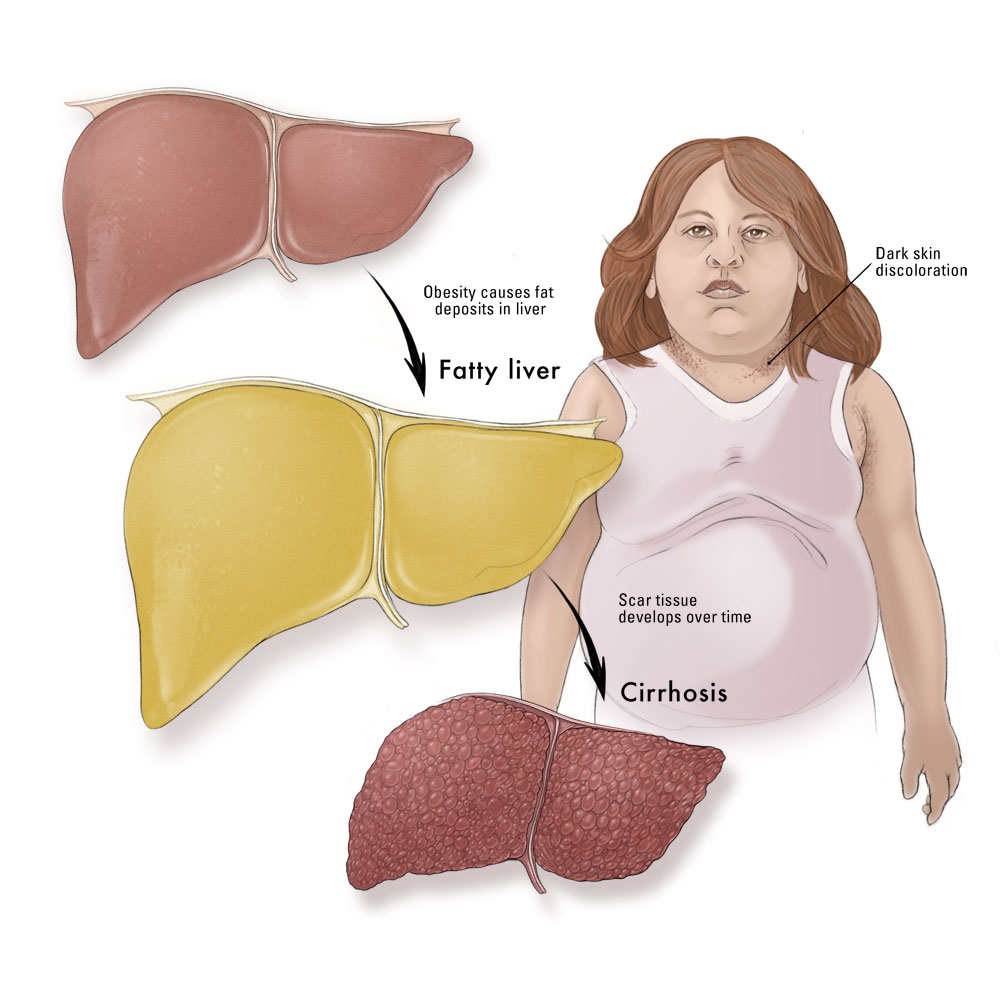Teen Non-Alcoholic Fatty Liver Disease On Rise
You may, like me, be tired of hearing about all the medical problems and warnings these days; but, as if we’ve not had enough already, there’s one more to either: keep you up at night or spur you into taking action.
It’s true, the fact that we’ve learned over 25% – one-fourth – of our children in the US meet the criterion for obesity is becoming old news; but, that it has caused fatty liver disease (FLD) in teens to skyrocket, caught even me off guard.
What’s the Problem With Fatty Liver Disease?
Fatty Liver Disease is when the normal liver cells become so infiltrated (saturated) with fat deposits that they not only completely change color, the liver cannot do its normal job adequately. And you know that the liver not doing its job means big, big problems.
There’s several causes of Fatty Liver Disease; but, overall, alcoholism is by far the most common giving rise to two names: Alcoholic FLD and Non-alcoholic FLD.
And we now know that the prevalence of Nonalcoholic Fatty Liver Disease (NAFLD) has more than DOUBLED among US adolescents since the late 1980s. (We know it has also in other parts of the world as well, but the US is where this study was performed.)
The Research Study
A study reported in the Journal of Pediatrics analyzed several National Health Examination Surveys (NHANES) for 12 to 19 year olds to track the NAFLD prevalence rates from 1988-1994 to 2007-2010. Any overweight or obese child with an elevated alanine aminotransferase (ALT) enzyme level was considered to have suspected NAFLD.
 Using the latest standards for “normal” levels of enzymes as well as height/weight standards the data shows that the prevalence of suspected NAFLD increased from 3.9% in 1988-1994 to 10.7% in 2007-2010.
Using the latest standards for “normal” levels of enzymes as well as height/weight standards the data shows that the prevalence of suspected NAFLD increased from 3.9% in 1988-1994 to 10.7% in 2007-2010.
Additionally, they broke down all the data into groupings that revealed more surprising finding.
- The increasing trends occurred in all race/ethnic groups, both males and females, and in both obese and overweight children (although those merely over-weight didn’t reach statistical significance)
- Mexican Americans had the highest prevalence.
- Non-Hispanic blacks had the lowest prevalence.
- Suspected NAFLD prevalence was two to three times higher among males than among females.
- Over a quarter (27%) of obese females had suspected NAFLD.
- Nearly HALF of obese males (48.3%) had suspected NAFLD.
The Rest of the Story
So, overall, the factors associated with increased NAFLD (the risk factors) include increased age, increased body-mass index z-score, Mexican American ethnicity and… just being male.
Now lest we think this is just a fluke observation, it agrees with previous studies as well which specifically showed that increased consumption of sugar sweetened beverages was associated with NAFLD risk.
I’ve even seen an Italian doctor in the medical news recently (Valerio Nobili, Rome) who made a similar revelation and distressing statement about his own country. He reported that more than a million children in Italy now have NAFLD (not sure how that stands with percentages of children).
Distressingly he went on, “We must take preventive health policies [seriously] if we want to avoid this generation of teens, which will have a life expectancy less than that which preceded it!”
What I Would Do
First, the researchers concluded that it is important to screen overweight adolescents for liver disease and I now must agree.
With a quarter of all females and half of all males who are overweight having ALT indications of liver disease, a smart physician will add that to the yearly physical exam every teenager should be receiving.
In fact it is of strategic importance “to diagnose this disease before it progresses to such an advanced state that will render unnecessary any treatment other than liver transplantation.”
 Second, pediatricians have just got to quit tap-dancing around the assumed parent’s and child’s tender sensibilities and begin calling a spade a spade. Having your old, bald-headed – but kind – pediatrician tell you are too over weight, even obese, is much, much, much more preferable than telling you of your liver disease!
Second, pediatricians have just got to quit tap-dancing around the assumed parent’s and child’s tender sensibilities and begin calling a spade a spade. Having your old, bald-headed – but kind – pediatrician tell you are too over weight, even obese, is much, much, much more preferable than telling you of your liver disease!
Preventing children from becoming overweight will prevent most NAFLD. We need to begin doing whatever it takes to convince and motivate parents of young children to:
- Do NOT permit sugar sweetened drinks,
- LIMIT TV and other SCREEN TIME (i.e. games, texting etc.) to one hour per day (except specifically related to homework in older children),
- SERVE 1/2 plate vegetables, and
- Ensure at least 60 minutes of good physical activity per day.
And Third, “The most important step, and unfortunately the most difficult, must be to persuade the food industry to package foods more healthy and less processed chemically – i.e. reduce the profit margin (yea right!) for the benefit of quality.”
That’s what Dr. Nobili told the world press… and I whole-heartedly agree.
[J Pediatr 19 Oct 2012]
Advertisement by Google
(sorry, only few pages have ads)


